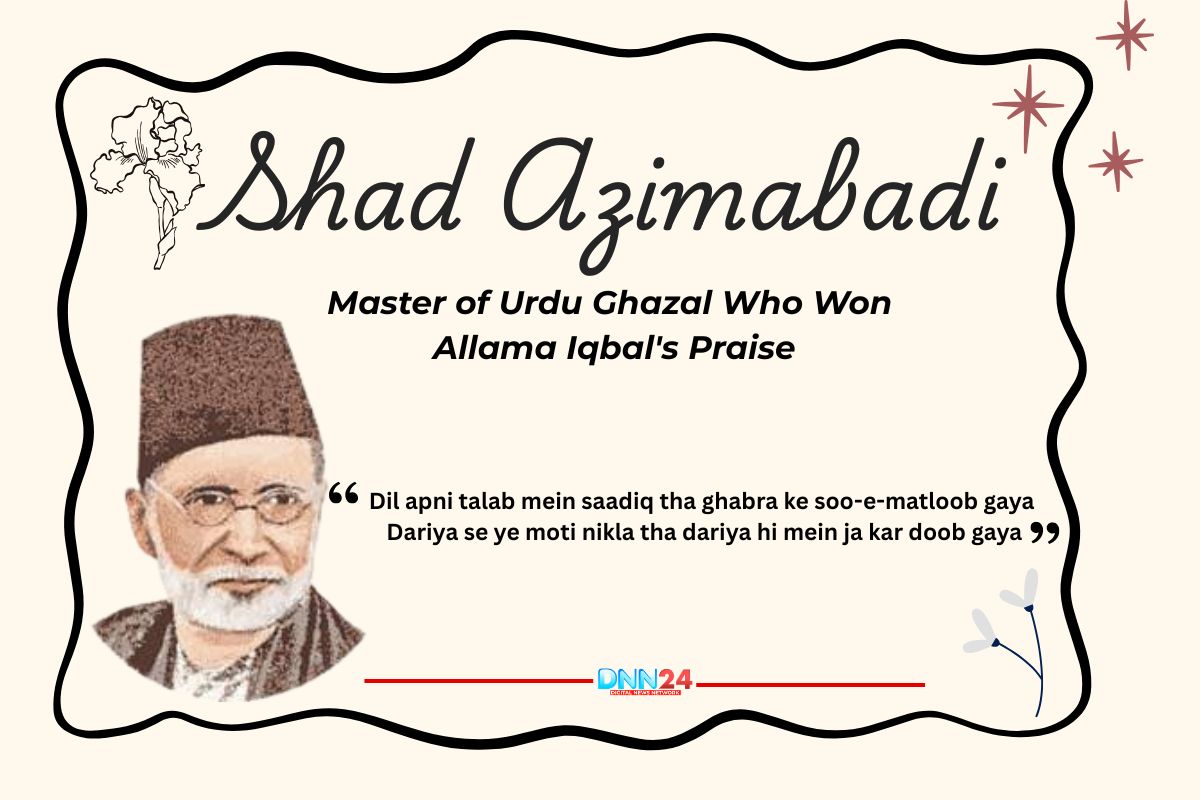In the grand tradition of Urdu poetry, three names form an unbreakable chain. Mir Taqi Mir laid the foundations with his heartrending verses about love and loss. Mirza Ghalib brought philosophical depth and linguistic brilliance to the ghazal. Then came Shad Azimabadi, who preserved this magnificent legacy while infusing it with warmth and human truth. Critic Kalim Uddin Ahmad recognised him as the third pillar of Urdu ghazal, completing a trinity that defined the form for generations.
Khamoshi se musibat aur bhi sangeen hoti hai
Shad Azimabadi
Tadap ai dil tadapne se zara taskeen hoti hai
His poetry embodies the refinement of classical traditions while possessing a personal voice that distinguishes him from mere imitators. The renowned critic Majnoon Gorakhpuri called him “the poet of moist sorrows,” capturing the emotional authenticity that pervades his work. Even Allama Iqbal, one of the greatest minds in Urdu literature, deeply admired Shad’s verses. This recognition from a towering intellect speaks volumes about the quality and depth of Shad’s artistic achievement.
Ye bazm-e-mai hai yahan kotah-dasti mein hai mehroomi
Shad Azimabadi
Jo badh kar khud utha le haath mein meena usi ka hai
A Voice That Saved the Ghazal
Shad’s emergence came at a critical moment for Urdu poetry. Critics were relentlessly attacking the ghazal, dismissing it as superficial entertainment trapped in outdated themes. They questioned whether this classical form could speak to modern sensibilities or address contemporary concerns. The ghazal faced accusations of being little more than repetitive expressions of unrequited love dressed in mystical symbolism.
Ab bhi ek umr pe jeene ka na andaaz aaya
Shad Azimabadi
Zindagi chhod de peecha mera main baaz aaya
During this period of severe doubt, Shad stood firm through his work, demonstrating that the ghazal could evolve without betraying its essence. He proved that this poetic form was not merely a vehicle for romantic tales between lovers and beloveds. His verses showed how ghazal could become a mirror reflecting the full spectrum of human experience and life’s profound depths. He addressed universal themes of mortality, suffering, wisdom, and beauty while maintaining the formal elegance that defined the tradition.
Dil-e-muztar se poochh ai raunaq-e-bazm
Shad Azimabadi
Main khud aaya nahi laaya gaya hoon
On the literary front, his achievement lay in adopting classical patterns while transforming them into genuine, deeply felt literature. He did not simply copy the masters before him but absorbed their techniques and made them distinctly his own. His verses combined technical mastery with emotional authenticity, satisfying both scholarly critics and everyday readers. The warmth, passion, and yearning in his couplets continue to move audiences, proving that authentic art transcends its historical moment and speaks across generations.
Tamannao mein uljhaya gaya hoon
Shad Azimabadi
Khilaune de ke behlaya gaya hoon
From Aristocratic Childhood to Secret Poetry
Shad Azimabadi was born as Syed Ali Muhammad in 1846 in Azimabad, the city now known as Patna. His family belonged to the regional aristocracy, enjoying considerable wealth and social standing. His father, Syed Tafazzul Husain, was counted among the prominent nobles, commanding respect throughout the area. The household blended religious devotion with appreciation for learning, though literature was viewed with suspicion.
Sun chuke jab haal mera le ke angdaai kaha
Shad Azimabadi
Kis ghazab ka dard zalim tere afsane mein tha
From childhood, Shad displayed exceptional intelligence and a remarkable ability to absorb knowledge. By the age of ten, he had mastered the Persian language and literature, an extraordinary achievement that revealed his intellectual gifts. He began composing poetry at a remarkably young age, demonstrating a natural talent for verse. However, his literary pursuits met fierce opposition from his parents, who considered poetry a frivolous waste of time.
Jaise meri nigah ne dekha na ho kabhi
Shad Azimabadi
Mahsoos ye hua tujhe har baar dekh kar
They wanted him to travel to Iraq for religious studies, hoping he would become a respected theologian. But Shad’s heart belonged to poetry, and he continued writing in secret, hiding his manuscripts from the disapproving eyes of his family. Eventually, his passion could not be contained, and he sought formal training under Syed Altaf Husain Faryad, a respected poet. This decision marked the true beginning of his literary journey, though it likely caused lasting family tension.
Kaun si baat nai ai dil-e-nakaam hui
Shad Azimabadi
Shaam se subah hui subah se phir shaam hui
The Price of Devotion
Shad’s love for books and study consumed him completely. He spent entire nights reading and writing, often forgetting basic needs like food and rest. This relentless pursuit of knowledge and artistic perfection ultimately took a toll on his health, even at a young age. He developed serious ailments affecting his stomach and heart, conditions that plagued him throughout his life.
Dhoondoge agar mulkon mulkon milne ke nahi nayab hain hum
Shad Azimabadi
Jo yaad na aaye bhool ke phir ai hum-nafaso wo khwab hain hum
Doctors warned him repeatedly, prescribing rest and moderation, but their advice went unheeded. Shad could not imagine abandoning his literary work for physical comfort. He continued his exhausting schedule, fully aware of the consequences. This stubborn dedication meant he spent his entire life battling illness and its complications.
Tera aastan jo na mil saka teri rahguzar ki zameen sahi
Shad Azimabadi
Humein sajda karne se kaam hai jo wahan nahi to kahin sahi
Yet this suffering enriched his poetry, adding depth and authenticity to his exploration of pain and vulnerability. His personal experience with physical limitation informed his verses in ways pure imagination never could. The ache in his body translated into the ache in his words, creating resonance that readers felt deeply. His refusal to compromise his artistic calling reveals the intensity of his commitment and the profound nature of his creative drive.
Kahan se laau sabr-e-hazrat-e-ayyub ai saaqi
Shad Azimabadi
Khum aayega suraahi aayegi tab jaam aayega
Recognition and Literary Maturity
Shad’s breakthrough came through a fortunate meeting with Sir Abdul Qadir Sarwari, editor of the prestigious magazine “Makhzan.” When Sarwari visited Patna and heard Shad recite his work, he recognised significant talent immediately. The classical refinement, combined with fresh emotional power, convinced him that he had discovered someone special. Sarwari began publishing Shad’s poetry in “Makhzan,” giving him exposure across the Urdu-speaking world.
Dekha kiye wo mast nigahon se baar baar
Shad Azimabadi
Jab tak sharaab aayi kai daur ho gaye
This platform proved transformative, as the magazine reached educated readers throughout India and beyond. Shad’s name began to appear in serious literary discussions, marking his arrival among established poets. He composed not only ghazals but also elegies, quatrains, and odes, demonstrating remarkable versatility. His poetry was characterised by critics as possessing a philosophical temperament, engaging with life’s more profound questions and human experiences.
Main ‘Shad’ tanha ek taraf duniya ki duniya ek taraf
Shad Azimabadi
Saara samundar ek taraf aansu ka qatra ek taraf
There was particular warmth and yearning in his couplets that distinguished them from mere technical exercises. His style remained elegant and refined, never crude or careless. He neither broke with tradition nor simply repeated old patterns. Instead, he expanded the tradition, adding new dimensions while respecting its fundamental character.
Main hairat o hasrat ka maara khamosh khada hoon saahil par
Shad Azimabadi
Dariya-e-mohabbat kehta hai aa kuchh bhi nahi paayab hain hum
Beyond Poetry: History and Controversy
Shad’s talents extended into prose writing and historical scholarship. His novel “Peer Ali” dealt with the events of 1857 and is recognised as the first historical novel in Urdu literature. In 1876, when the Prince of Wales visited India, Shad received a commission to write the history of Bihar. He produced three volumes, though only two were published. His book “Nawae Watan” created tremendous controversy in Patna society.
Suni hikayat-e-hasti to darmiyan se suni
Shad Azimabadi
Na ibtida ki khabar hai na intiha maaloom
In this work, Shad criticised the language and behaviour of aristocratic families in Azimabad and Bihar, holding up an unflattering mirror to their pretensions. The local elite reacted furiously to this frank assessment. Newspapers published harsh attacks, protesters gathered outside his house, and demonstrations treated the book’s publication like a death in the community. This response reveals both the impact of his writing and the courage required to publish such criticism.
Hoon is kuche ke har zarre se aagaah
Shad Azimabadi
Idhar se muddaton aaya gaya hoon
Despite severe backlash, Shad stood by his work, believing an honest assessment served society better than polite silence about the apparent decline among the privileged classes. He also founded a weekly newspaper called “Naseem-e-Sahar” in 1874, which continued for seven years, giving him another platform for engaging with contemporary issues beyond his poetry and fiction.
Nazar ki barchhiyaan jo sah sake seena usi ka hai
Shad Azimabadi
Hamaraa aap ka jeena nahi jeena usi ka hai
Public Service and Changing Fortunes
Shad’s influence reached into civic life as well. He served as a member of the Patna Municipality and later became Municipal Commissioner. In 1889, the British administration appointed him Honorary Magistrate, recognising his community standing. For much of his life, he enjoyed comfort and prosperity. When travelling, eight to ten servants accompanied him, maintaining the dignity expected of his social position.
Parw anon ka to hashr jo hona tha ho chuka
Shad Azimabadi
Guzri hai raat shama pe kya dekhte chalein
However, circumstances changed dramatically in his later years. Financial difficulties forced him to accept a pension from the British government, a humbling situation for someone who had known independence and affluence. He received funds for publishing books, house repairs, and basic expenses. This dependence on official support represented a significant fall from his earlier prosperity, though it did not diminish his dedication to literature.
Lahad mein kyun na jaaun munh chhupaye
Shad Azimabadi
Bhari mehfil se uthvaya gaya hoon
An Enduring Legacy
Over his lifetime, Shad composed approximately one hundred thousand verses and wrote dozens of prose works. Tragically, much of this vast output deteriorated or remained unpublished. His autobiography, “Shad ki Kahani Shad ki Zabani,” remains an invaluable document, offering direct insight into his life and thoughts. Despite chronic illness, harsh criticism, and financial struggles, Shad never abandoned poetry and literature.
Hazaar shukr main tere siwa kisi ka nahi
Shad Azimabadi
Hazaar haif ki ab tak hua na tu mera
He continued working until the end, contributing to Urdu letters even when circumstances might have justified retirement. On January 8, 1927, his long battle with illness ended. Yet his poetry survived, carrying forward the warmth of his verses and the depth of his thought. Shad Azimabadi breathed new life into the Urdu ghazal during a period when the form faced existential questions.
Izhaar-e-mudda’a ka iraada tha aaj kuchh
Shad Azimabadi
Tewar tumhare dekh ke khamosh ho gaya
He carried forward traditions established by Mir and Ghalib while stamping them with his personal seal. His poetry reflects human experience, pain, reality, and beauty in ways that remain moving and accessible. When we turn the pages of Urdu literary history today, his name shines like a star that refused to dim. He kept the lamp of ghazal burning through unwavering dedication, ensuring that this precious tradition would continue to illuminate the path for future generations.
Also Read: Tahzeeb Hafi: Simple Words, Deep Emotions, and the Modern Urdu Poetry Revolution
You can connect with DNN24 on Facebook, Twitter, and Instagram and subscribe to our YouTube channel.

